

Table of contents
- Location
- Cultivating in the bog bed
- plant substrate
- watering & fertilizing
- feeding & sustenance
- sorts
- repot
- Cut
- hibernate
- multiply
- Diseases & Pests
Carnivorous plants represent a plant group that is exceptional in botany, both in terms of exotic form and feeding habits. The carnivores have special requirements when it comes to the plant substrate, and most varieties also need a lot of light at their location. No compromises should be made when it comes to irrigation water either, otherwise the plants will wither quickly and will not form attractive traps.
Location
Carnivorous plants do not tolerate locations that are too dark, so the plant should be in a place right by the window. The window sill does not always have to be south-facing, many varieties can also be arranged with an east- or west-facing window. North-facing windows are typically far too dark, as are indoor locations that lack light. An exception is butterwort, which can also thrive on a north-facing window. In addition, a place directly above a radiator is also not suitable, as the air dries out far too quickly there. In this case, parts of the plant will dry up, which is harmful to the sensitive plants. During the warm summer months, the carnivores can move outdoors, but they also need high humidity there.
- Need an extremely sunny spot
- A south-facing window is ideal
- Heat requirement depends on the species
- Avoid too hot midday sun
- Shade from too much sun exposure
- Pay attention to permanently high humidity, 70% is sufficient
- Perfect locations are terrariums or aquariums
- Never close containers completely to avoid heat build-up
- In summer you can move outside, either in the garden, on the terrace or on the balcony
- Cultivate native varieties in bog beds
Tip:
If the location has too little light, artificial light can also be used. Light bulbs with 120 to 150 watts per square meter are ideal, so that the carnivorous plant has enough light.
Cultivating in the bog bed

There is a lot of design freedom with the bog bed, but no foreign nutrients should get into this habitat. For this reason, no trees or bushes should be nearby. Furthermore, predators are a problem when kept outdoors, which is why the bog bed needs an additional protective device. Otherwise it can lead to a fatal attack by snails and birds.
- Lay out a suitable place with waterproof pond liner
- Fill with plant substrate and keep constantly moist
- Pay attention to a sunny location
- Install water tank
- Ideal for sundew, butterworts and pitcher plants
- Tension close-meshed chicken wire as protection
plant substrate
The carnivores need a very specific plant substrate, which is mixed from different components. These mixtures are available in specialist shops, but they are not particularly cheap. Anyone who has already gained some experience with cultivating carnivorous plants can mix the substrate themselves. It should be noted that the respective proportions of the ingredients are composed depending on the respective variety. If the conditions are not right, this can have a negative effect on the crops. For this reason, beginners should rather rely on the help of professionals. Nurseries specializing in carnivores also offer purpose-built mixes to improve plant growth.
- Need a nutrient-poor plant substrate
- Never use normal garden or potting soil
- Special carnivore soil is ideal
- Observe the basic needs of the varieties
- Alternatively, white peat can be mixed with quartz sand
- Plant substrate must not contain any fertilizer
- Ready-made mixes contain quartz gravel, coconut fiber, quartz sand, perlite and vermiculite
- Special mixtures are available in specialist shops
- Beginners should not take any risks with the substrate
watering & fertilizing

Carnivorous plants are very sensitive to lime in the irrigation water, and over time they can even die completely. In many regions the tap water is very hard and therefore not suitable for watering carnivores. If you have an osmosis system for the tap water, you can safely use the filtered water for the carnivorous plants. An alternative is collected rainwater, but this can be contaminated in large cities. The plants should not be watered directly, but via an external saucer. Only when this irrigation water has been completely used up should it be watered again. In between, let the plant dry for a short time and do not water immediately. In this way, the plant substrate gets the chance to air out, this process only works when it is dry. If there are problems with growth, additional fertilizer is required.
- Never use hard water
- Distilled water is ideal
- Alternatively, demineralized water is possible
- Pour over the coaster
- Water level should be 2-3 cm after pouring unit
- Pay attention to high humidity
- Spray regularly with steam
- Never give regular fertilizer
- Fertilization is carried out by feeding from spring to autumn
- Only use special liquid fertilizers for carnivores
feeding & sustenance
As a rule, carnivorous plants provide themselves with food and do not need to be fed additionally. If the carnivores occasionally catch a small insect, then they are well cared for. Even in the cooler winter months, it is still possible to catch them, as there are always some insects in living spaces. However, if you want to feed the plants yourself in order to observe this fascinating process, you should follow a few rules.
- Only use live insects
- Traps only snap shut when the insect is still moving
- Loot must never be too big
- Size of insects should not be more than a third of the trap
sorts
With the varieties of carnivorous plants, a distinction is made between tropical and native species, which are also equipped with different traps. In the case of the sticky traps, the caught insect gets stuck on a sticky secretion, after which enzymes decompose the victim. This group includes the sundew. The snap traps are composed of two halves of the leaf, which collapse when they come into contact with insects. A well-known example is the Venus Flytrap. The largest genus of carnivorous plants are the water bladders, which have evolved into many fascinating species. The water hoses work with suction traps, which are catching organs filled with air, which suck in their victims with a negative pressure. The pitcher plants, which set a trap for insects, belong to the pitfall traps. In contrast, pot traps lure the insects inside with attractants. Small bristles then prevent the animals from escaping.
venus flytrap

The Venus flytrap thrives both in bog beds and in indoor culture, but the plants usually withdraw to the rootstock from autumn.
- Needs lots of sun
- High humidity in summer
- A terrarium or an additional glass bowl is ideal
- Healthy and strong specimens survive even frosty winters
- Keep indoor plants cooler in winter, at 5-10°C
- Lower humidity during the winter months
- Neither feed nor fertilize
sundew

The sundew bears the botanical name Drosera capensis and forms distinctive sticky traps. However, if the air is too dry, no sticky droplets form and the plant cannot catch insects.
- Prefers lots of sunlight
- Always pay attention to high humidity
- Ideal for indoor cultivation as it is not frost hardy
- Possible to move outside in summer
- Overwinter at room temperatures
Butterwort

The butterwort bears the botanical name Pinguicula vulgaris and thrives best outdoors. Unlike other carnivores, this strain is not particularly demanding when it comes to humidity.
- Belongs to the sticky traps
- Ideal for the bog bed
- Alternatively in pots in the garden, on the balcony or terrace
- Prefers partially shaded locations
- Can also overwinter outdoors
- Forms flowers in summer
water hose

The water bladder has the botanical name Utricularia sandersonii and can be cultivated well in a pot. However, the planter should always be in the water so that the plant does not dry out.
- Bright location
- Avoid direct midday sun
- Requires high humidity, fill coasters with 2-3 cm of water
- Clean coasters regularly and thoroughly
- Forms pretty flowers
pitcher plant
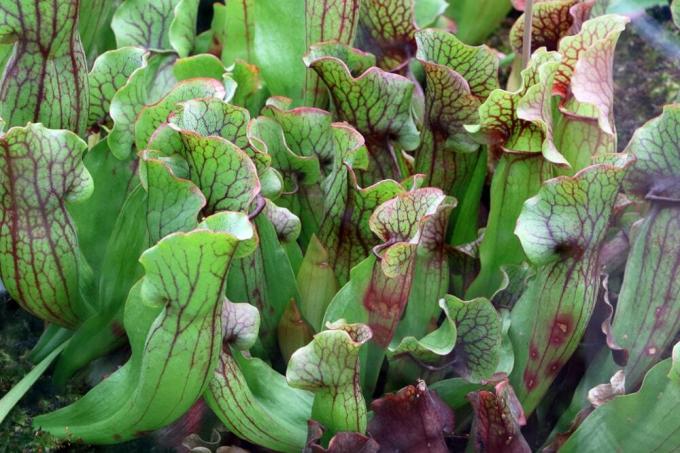
The pitcher plant is called Nepenthes in botany and forms pitcher-shaped traps that are responsible for catching small insects.
- Bright but not too sunny location
- Sensitive plant burns in the midday sun
- Watch out for shade during lunchtime
- Increase humidity by regular spraying
repot
Since the carnivorous plants should always be kept moist, it is advisable to change the plant substrate regularly. Otherwise it can lead to an infestation with mold, which offers an ideal breeding ground for other diseases. The used substrate should be completely replaced to also prevent shortages. However, the entire flower pot does not always have to be replaced, the roots grow slowly but steadily. A change is only necessary when the vessel is too small and roots are showing on the outside.
- Repot every spring
- Use fresh and airy plant substrate
- Roots are extremely sensitive
- Avoid damage at all costs
- Careful handling is advised
- Slowly peel off the substrate under a lukewarm shower
- Protect traps and leaves from repotting
- Wrap with cardboard or foil
Cut
Carnivorous plants are not dependent on pruning to shape them. Only the dead plant parts should be removed. If the plant gets too big and takes up too much space in the aquarium or terrarium, it is better to divide it. In this way, the growth can be controlled in a natural way.
- Regularly remove completely dried parts
- Proceed carefully
- Cutting will only weaken the plants unnecessarily
hibernate
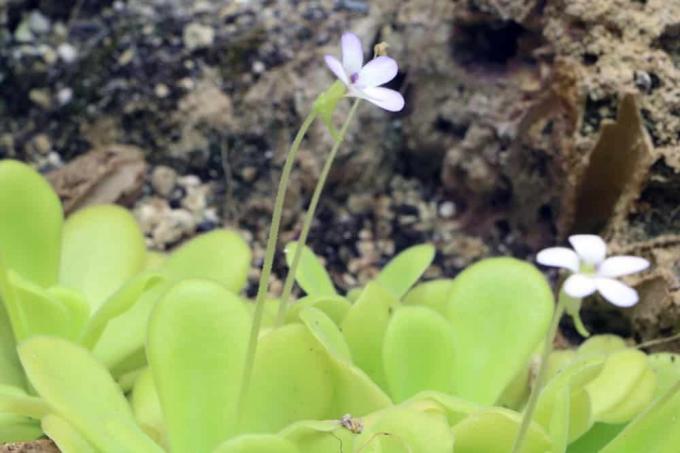
The winter season represents a difficult phase for carnivorous plants, as they often do not get enough light during this time. If the site cools down at the same time, then this circumstance will not negatively affect the carnivores. However, most living spaces are heated and therefore warm for long periods of time even in winter. In addition, some of the carnivorous plants are dormant and therefore need a cooler winter quarters.
- Brighten up too dark but warm locations with plant lamps
- Depending on the variety, external winter quarters are required
- A bright location with temperatures between 5-10° C is ideal
- There are bright corridors and unused guest rooms
- If the temperature is too low, growth will stop
- Leaves turn brown in the wrong site conditions
multiply
Carnivores can be reproduced in a number of ways, none of which are particularly easy. Therefore, it is better only for breeders with relevant experience to tackle this. A great deal of sensitivity and daily care and checking of the plants are required. Carnivorous plants can be propagated with the help of seeds, cuttings and division of the rhizomes.
seed
- Seeds don't last long
- For some varieties, seeds need prior treatment
- Pre-treat with either cold or heat
- Almost all varieties are light germinators
- Lay the seeds loosely on the plant substrate
- Keep consistently moist
leaf cuttings
- Press cuttings onto fresh plant substrate
- Then cover the petiole with some substrate
- Cutting roots immediately in the substrate
- Alternatively, place the cuttings in a glass with distilled water and cover
- Always keep young plants moist at the beginning
- Get used to normal casting units very slowly
root cuttings
- Cut off a healthy piece of root
- Plant separately
- Keep moist initially
- Weak specimens do not tolerate this method
rhizome division
- Take the plant completely out of the pot
- Break into several pieces
- Plant individual parts separately
- Always tread carefully
Diseases & Pests
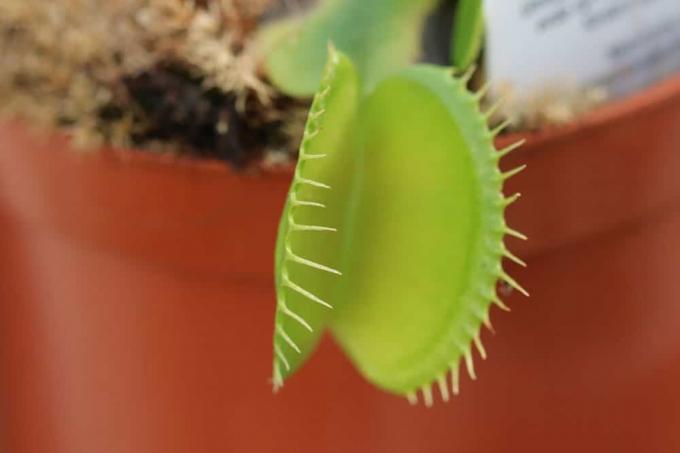
If the site conditions and care are right, then diseases rarely occur. It is difficult to protect plants from infestation with pests. Therefore, the carnivores should be checked regularly for an infestation and the first signs of disease. In the initial stage, it is very easy to take appropriate countermeasures.
gray mold
- Occurs mainly in the winter season
- Too damp and cold conditions are ideal breeding ground
- Remove affected parts of the plant immediately
- Administer significantly fewer watering units
- Keep affected plants isolated
- Choose a light and airy location
- For prevention, regularly remove dead plant parts
Mold in the plant substrate
- Only a visual problem
- Resolve by prompt repotting
- Use an airy substrate
- Ventilate the site regularly
- Water less in winter
aphids
- Plants are sensitive to infestation
- Rinse insects gently with soapy water
- Use aphid spray to combat extremely tender plants
- Use suppositories with a long-term effect as a preventive measure
scale insects
- Very harmful, can lead to the death of the plant
- Hard-leaved varieties are particularly susceptible
- Insert solution with contralineum
- Foliar shine spray can help
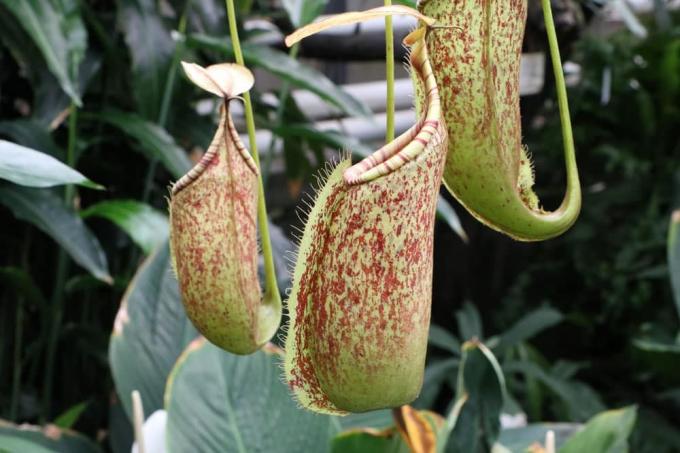
spider mites
- Timely detection is ideal
- Control with aphid or mite spray
caterpillars
- Possible when staying outdoors
- Collect voracious pests from the plant
snails
- Possible when cultivating in a bog bed
- Collect and remove
- Use slug pellets as a preventative
 garden editorial
garden editorial I write about everything that interests me in my garden.
Learn more about carnivores

Carnivorous plants, carnivores - the most popular species
Carnivorous plants fascinate botanists and gardeners. The tricky trappers are available from tiny to majestically large, in impressive colors and furious shapes. Get to know the most popular types of carnivores for windowsills, balconies, garden ponds and beds.

Repotting carnivorous plants - information on keeping them in the terrarium
Carnivorous plants are an outlandish creation of nature, preferring to hunt in warm and humid areas. But they also have admirers in this country. But how do they deal with our climate? How can we create a second home for them here?

Pitcher plant, Nepenthes - care from A-Z and feed properly
The pitcher plant or Nepenthes is a carnivorous plant that enjoys great popularity - but it is not easy to cultivate. Interested parties can find out here what is important when caring for them from A to Z and how to feed them correctly.
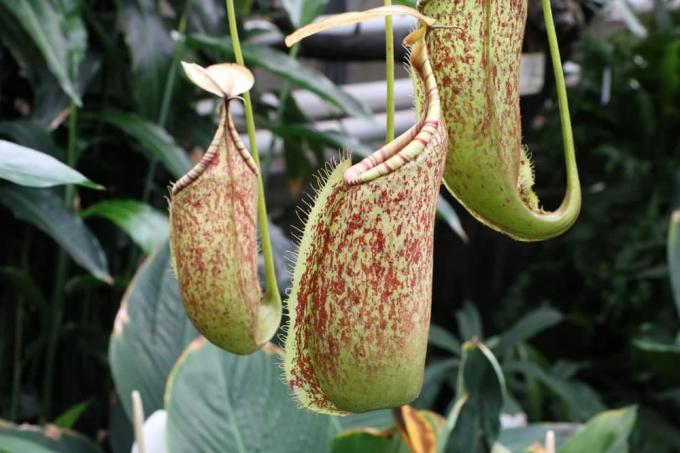
Propagating pitcher plants and overwintering - this is how it works
Catch an insect with a pitcher? Only a plant can come up with this funny idea. But it works! With the pitcher, the pitcher plant not only catches insects, but also the hearts of many plant lovers. How to grow even more Nepenthes.

Successfully overwinter carnivorous plants
They just catch a fly for a meal. A bit bizarre if you consider that we are talking about plants here. But that is exactly what makes it so appealing. How do these strange plants survive the cold and "flyless" winter in this country?

Venus Flytrap: Basics of Care, Watering, and Feeding
The flowers are clearly secondary, the leaves are the highlight here - when they come into action! They are the green hunter's catching tools. The Venus Flytrap needs live prey like it needs air to breathe. Does she have any other unusual wishes?



